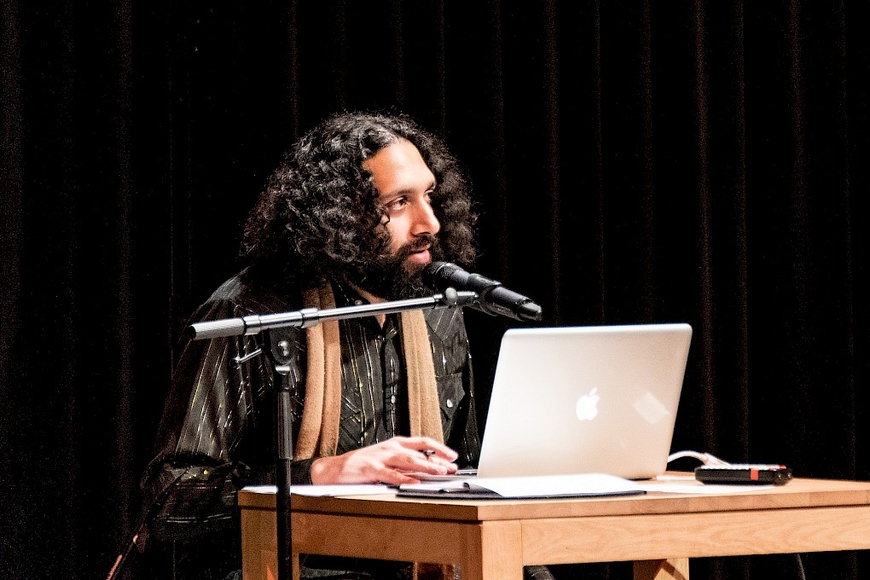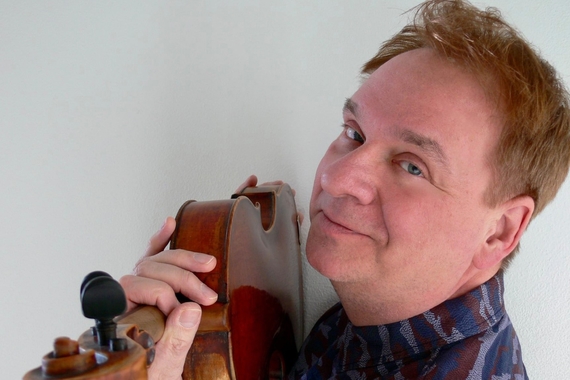Talking Steve Reich with Sumanth Gopinath
Steve Reich is often described as America’s greatest living composer. His richly textured compositions are credited with changing the course of musical history. And yet, his music is largely under-researched.
Sumanth Gopinath, associate professor of music theory, discusses the new sources and insights on Reich revealed in his book Rethinking Reich, co-edited with Pwyll ap Siôn. Gopinath will give a reading from the book on July 31 from 7:00 - 8:00 pm at Moon Palace Books in Minneapolis.
What did you learn about Reich and his music through the process of producing this book?
I learned a number of fascinating things. For example, it turns out that Reich’s music is heard at the beginning of the main fight sequence in the movie The Hunger Games (2008), and his compositions have also been featured in a number of queer-themed films and television shows. Also, and perhaps more surprisingly, John Pymm notes in his chapter that Reich paid recording royalties to Daniel Hamm who was one of the “Harlem Six” wrongly accused of murder around the time of the 1964 Harlem riots/uprisings and who was acquitted only in the 1970s. (Their case became a cause célèbre, and the Harlem Six were championed by James Baldwin, Ossie Davis, Allen Ginsberg, John Lennon and Yoko Ono, Truman Nelson, Bertrand Russell, and numerous others. Reich used a recording of Hamm’s voice in a 1966 composition of his called Come Out.)
In Martin Scherzinger’s chapter, he argues that a great many of Reich’s compositions draw directly on transcriptions of traditional sub-Saharan African music and on African musical practices—much more often than we have previously believed to be the case. And, in Celia Casey’s chapter, she discovered that Reich coached interviewees to get them to perform their “documentary” material in ways that appealed to him (in WTC 9/11, a piece he composed in 2009–2010 using voices of first responders to and numerous other first-hand witnesses of the World Trade Center attacks on Sept. 11, 2001). In doing the research for my own chapter, I came to realize a number of intriguing things about Reich’s composition Four Organs (1970), including that it was one of the earliest “mature” works of Reich to rely heavily on sketches, that its connections to contemporary popular music are much deeper than have been previously considered, and that reports of the furor infamously caused by its performance at Carnegie Hall in 1973 were likely exaggerated and/or invented—possibly by conductor/keyboardist Michael Tilson Thomas.
What questions guided your work in publishing Rethinking Reich?
A few concerns came to mind. First, we wanted to draw on the wealth of new research on Reich that had been opened up by the Sacher Foundation’s acquisition in 2008 of the composer’s archive, which dramatically transformed how one could study his music and life. This meant recruiting both emerging scholars and established experts who had been spending time in the archive—like ourselves, the editors. Second, as has long been one of my interests in writing on Reich, the composer has very powerfully represented his practice and ideas in writings and interviews, he but has done so in ways that have occasionally occluded more complex and critical understandings of what he has been up to and why. This book is a collective attempt at rectifying that imbalance. Third, we had hoped to release the volume around the time of the composer’s 80th birthday concert season (2016–17), but obviously we were a little late in getting it done!
How did you and your co-editor Pwyll ap Siôn select the contributing authors and research?
The genesis of this project goes back a decade, to 2009, when several of the contributors were in attendance at the Second International Conference on Minimalist Music in Kansas City, Missouri. At that time, I casually proposed putting together an edited volume on Reich’s music to a couple of conference attendees in light of the then-new Sacher acquisition, which I hadn’t yet seen. These attendees, who were younger scholars, presented new work on Reich that was exciting to me and deserved to be in print. But the idea lay dormant until the Fourth International Conference on Minimalist Music in Long Beach, California in 2013, when more inspiring work on Reich (again, mostly by younger scholars) reanimated the effort, and it was at this time that Pwyll and I decided to join forces and write up a book proposal for Oxford University Press. Once the project was officially underway, we also made sure to request chapters from established scholars who either were actively working on Reich or had incisive things to say and could be coaxed into writing for the volume. In the end, we got a great mix of contributions that we’re really happy with.
As far as the content of the contributions themselves is concerned, we mostly gave our authors free rein to write on whatever aspects of Reich’s life and music they saw fit (which led to some unintended clusters of focus, such as Reich and Beryl Korot’s 1993 video opera, The Cave). We shaped the contents of the volume thereafter, primarily through often rather extensive feedback. Having seen a number of our authors’ chapters as presentations first, however, we did have a good idea of what we’d be getting in those cases. In a few other instances, specific topics that seemed essential were lacking and so we sought out the most expert person we could find to write on them—as was the case with ethnomusicologist and Indonesian music expert Michael Tenzer, who writes insightfully on Reich’s relationship to Balinese music, which the composer read about and studied in the late 1960s and 1970s. Robert Fink’s deft handling of Reich’s treatment of speech and the written word in The Cave was the product of another specific request, as was Matthias Kassel’s chapter (mentioned below).
Can you share more about the Steve Reich Collection at the Paul Sacher Foundation?
Fortunately, one of the chapters in the book was written by Matthias Kassel, who is the curator of the Reich archive at the Sacher Foundation. Kassel provides a fair amount of detail about what is actually there and writes insightfully on the challenges of managing this particular archive. As he notes, one of the major difficulties involved is working with outdated digital technology, including old Macintosh computers and corrupted floppy disks that contain unreadable files—materials that open up uncharted terrain for archival and music-analytical scholarship. Twila Bakker’s chapter also discusses Reich’s early adoption of music notation software and the ways in which it might have affected his compositional process. Of course, we strongly encourage scholars and musicians to get in touch with the staff at the Sacher if they’re interested in examining the holdings, which also include sketchbooks, diaries, letters, videos, musical equipment, and a large number of remarkable audio recordings (work tapes, live performance recordings, etc.).
Has Steve Reich read your book?
I learned that Reich recently obtained a copy and was pleased by what he found, which is a relief to me! He showed the book to music scholar and former arts administrator Renée Levine Packer, who in turn wrote to Pwyll about this. I don’t know how much of it he has read, however. At some point, hopefully once he’s gone through it, perhaps I’ll find a way to get in touch with him and get more extensive feedback on the volume. One of our authors, David Chapman, wrote an excellent study of the genesis of Piano Phase (1967) and corresponded with Reich on the importance and meaning of improvisation, about which Reich has written critically in a few places. Reich disagreed with aspects of what Chapman had to say but was in general supportive of the work and ideas conveyed in his chapter. To me, that spoke well of Reich and suggested that he’s willing to both engage with scholars who might have novel things to say about his music and offer corrections/criticisms in a generous way. (As Pwyll reminds me, Reich also corresponded with Ryan Ebright, another contributor, and the composer was interviewed by Celia Casey for her chapter as well—so his voice is certainly represented in the book in various ways.)
Steve Reich majored in philosophy and minored in music in college. Do you feel he would have thrived as a composer if he had pursued an undergraduate degree in composition?
I don’t think it would have made much of a difference. Reich studied philosophy and music while at Cornell and wondered himself whether it was too late to pursue a career in composition. His teacher, the renowned musicologist William Austin, was very supportive and played a profound role in encouraging Reich (including well after he’d graduated—in the Sacher archive, there is a moving letter from Austin to Reich on the 1967 LP release of Come Out, for example). Reich did later go to graduate school for composition at Juilliard and then at Mills College (where he studied with Luciano Berio), so it isn’t as if he was some kind of outsider musician.
My feeling is that there are many productive routes into composition, some via traditional degree programs and others not. (Consider, for example, the fact that the U of M’s own James Dillon, an internationally renowned composer and autodidact, never completed a college degree—even though he holds the “ideal” of higher education, in its widest sense, in great regard.) Moreover, Reich’s exposure to philosophy led to his study of Wittgenstein, whose writings have stayed with the composer since college. In his piece Proverb (1995), he even sets a short text of the philosopher’s: “How small a thought it takes to fill a whole life!”
Why have music critics and scholars of contemporary music referred to Steve Reich as America’s greatest living composer?
Steve Reich is arguably the most influential among a handful of creative musicians who transformed the landscape of contemporary composition mostly in the US (including people like Julius Eastman, Philip Glass, Meredith Monk, Phill Niblock, Michael Nyman, Arvo Pärt, Pauline Oliveros, Terry Riley, and La Monte Young) by markedly shifting what was acceptable as contemporary classical and experimental music during the 1960s and 1970s. This shift involved (re)introducing tonal and modal pitch-material, sustained drones, and/or regular, steady rhythms into musical flows that were apparently static or seemingly changed only very gradually. Referred to as “minimalism,” this tendency was influenced by and resonated with bebop, modal, and Latin jazz, rock music and R&B/soul, Indian classical music, (mostly sub-Saharan) African music, Indonesian gamelan, and selected strands from Western art music composition and performance (including the early music movement). Minimalism distinguished itself from a wide range of post-tonal musics in the US (including atonal modernism, twelve-tone and serialist music, Cagean aleatoric experimentalism, and free jazz), as well as more conservative art music traditions (neoclassicism and Coplandesque Americana, especially).
The name “minimalism” comes from the visual arts, and it seemed appropriate partly because many of these composers’ earliest concerts took place in art galleries and museums where minimalist art and sculpture was on display. The practice also typically featured composers performing their own music live, often in groups or ensembles that they formed and led. Reich’s importance within the minimalist cohort has at least four dimensions:
- His writings. In his published essays and interviews, Reich has theorized musical minimalism, as well as broader artistic trends of which it was a part, in remarkably clear and convincing ways.
- His compositional practice. As a composer, Reich has been particularly painstaking: he writes slowly and carefully, and as a result avoids repeating himself and tends to put out high-quality work. Moreover, for a long span of time—from the mid-1960s to the early 1990s—one could say that with nearly every successive piece, Reich broke new ground, technically and/or expressively.
- His critical acclaim. In part because of factor #2, Reich has been the most critically recognized among the minimalists, winning numerous awards including the Pulitzer Prize and the prestigious BBVA Foundation Frontiers of Knowledge Award. In terms of record sales among minimalist composers, his are reputedly quite high and likely surpassed only by Glass and perhaps Pärt (as well as Henryk Górecki, if he is included).
- His broader influence. Reich seems to have been taken up with great enthusiasm by both young US-American composers (particularly “postminimalists”—like the Bang on a Can group including Michael Gordon, David Lang, and Julia Wolfe—and their figurative descendants—like Judd Greenstein, Missy Mazzoli, and Nico Muhly) and by a wide range of popular musicians, from DJs and electronica acts who famously sampled his music (like The Orb) to rock/pop musicians as disparate as Captain Beefheart, Brian Eno, and Sufjan Stevens. Reich may even have been an influence on older composers like Morton Feldman, who was impressed by Four Organs and whose later music employed short, repetitive units in lengthy, slowly changing pieces—and notated in ways that even look like minimalist compositions.
Although I believe in Reich’s significance as a composer/creator, I put little stock in superlative claims to greatness and understand that statement mainly as a useful marketing tool — both for Reich and our own book.
Photo credit: Risa Galofre



